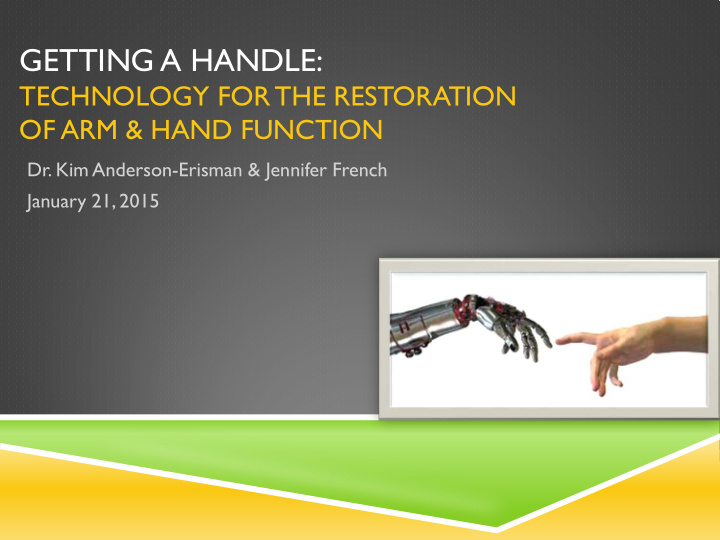



GETTING A HANDLE: TECHNOLOGY FOR THE RESTORATION OF ARM & HAND FUNCTION Dr. Kim Anderson-Erisman & Jennifer French January 21, 2015
Have a Question?
www.NeurotechNetwork.org Helping people regain life thru www.themiamiproject.org neurotechnology Focusing on education of and advocacy The Miami Project is dedicated to to access neurotechnology devices, finding more effective treatments therapies and treatments for people and, ultimately, a cure for paralysis living with impairments, their care-givers resulting from spinal cord injury. and medical professionals.
DISCLAIMER PAGE The information presented in this session is not meant to replace the advice from a medical professional. You should consult a health care professional familiar with your specific case, concerns and condition. Neurotech Network and its representatives do not endorse, rate, sell, distribute, prescribe, administer or recommend any products, procedures or services. We highly suggest for you to take information to a trained medical professional familiar with your case to discuss options that are best for you.
OBJECTIVES Anatomy of the arm & hand Common Clinical Concerns for Upper Extremity Impairment Understanding Terms: Exercise, Rehabilitation, Therapeutics & Prosthetics Overview of Assistive Devices Introduction to Neurotechnology Devices Repetitive Motion Therapy Sensing Orthotics Stimulating & Sensing Therapy Neural Prosthetics Resources to Learn More
ANATOMY OF THE ARM & HAND C4-5 C5-6 C6-7 C7-8 C8-T1
ANATOMY OF THE ARM & HAND
REHABILITATION VERSUS EXERCISE Rehabilitation: is a treatment or Exercise: is physical activity that is treatments designed to facilitate the planned, structured, and repetitive for process of recovery from injury, illness, the purpose of conditioning any part of or disease to as normal a condition as the body. possible. Focus is Focus is Improve health condition Restoration/recovery Maintain or improve fitness Compensation and Limitations/adjustment Prevention/performance Independence
THERAPEUTIC VERSUS PROSTHETIC Therapeutic Application: Prosthetic Application: Rehabilitative approach designed to Tool used to compensate or replace facilitate the process of recovery lost function. from injury, illness, or disease to as Focus is normal a condition as possible. Improve health condition Focus is Compensatory measures and Restoration/recovery Prevention/performance Voluntary control and Community Orientation
UPPER EXTREMITY: ASSISTIVE DEVICES Gripability http://gripability.de -Entirely mechanical Electric Powered Prehension Orthosis (EPPO) Wrist-Hand Orthosis http://www.broadenedhorizons.com JACO Robotic Arm: http://kinovarobotics.com -Uses wrist extensor strength to create a 3-point pinch -Prosthetic device mounted to wheelchair; controlled by a joy stick; has 7 degrees of freedom
UPPER EXTREMITY DEVICES - EXERCISE MotoMed: RECK RT300 Arm: Restorative www.ri-llc.com Therapies -Passive, motor-assisted, or active www.restorative-therapies.com Resitive -No research results available -Uses electrical stimulation to enhance arm cycling movement -No research results available
UPPER EXTREMITY DEVICES - EXERCISE Galileo UpX Dumbbell: Stim Designs stimdesigns.com -Vibration, depending on the frequency it can be used to enhance arm strength or promote relaxation of muscles There is research that shows that whole body vibration during exercise can improve upper body strength. More research is needed regarding the effectiveness in different neurologically impaired populations.
NEUROTECHNOLOGY: REPETITIVE MOTION THERAPY Armeo: Hocoma www.hocoma.com WAM Arm – Barrett Technology www.wambotics.com - Also called Robotic Rehabilitation Training - Studies show users have greater benefit if they begin with some minimal function
NEUROTECHNOLOGY: REPETITIVE MOTION THERAPY InMotion Interactive Therapy Interactive Motion Therapies interactive-motion.com AMES Therapy Device: - Motion Therapy may also improve AMES Technology sensorimotor impairments, www.amesdevices.com proprioception - American Heart Association & VA/DOD have recommended guidelines post-stroke
NEUROTECHNOLOGY: SENSING ORTHOTICS SaeboGlove: Saebo www.saebo.com MyoPro: Myomo www.myomo.com
NEUROTECHNOLOGY: SENSING & STIMULATING THERAPY MyndMove: MyndTec www.myndtec.com Biomove Home: Curatronic Ltd www.biomove.com Neuromove: Zynex Medical www.zynexneuro.com/neuromove/ - Devices combine voluntary movement with electrical stimulation - Studies show maintaining function movement post treatment
NEUROTECHNOLOGY: NEURAL PROSTHETICS Ness H200: Bioness www.bioness.com - Task specific training and movement - Studies have shown potential benefits of increase range of motion & hand function, reeducation of muscles, increase circulation & reduce muscle spasms
NEUROTECHNOLOGY: STIMULATING EXPERIMENTAL DEVICES www.ClinicalTrials.gov Contralaterally Controlled FES for Stroke STIMuGRIP: FineTech http://finetech-medical.co.uk/ http://fescenter.org Upper Extremity for SCI Freehand User Group http://fescenter.org
RESOURCES International Spinal Cord Society (ISCoS), www.iscos.org.uk Free download of this booklet: http://www.miamiproject.miami.edu/page.aspx?pid=428 Free Fact Sheet Resources Follow: Paralysis Support/Research Spinal Cord Injury, Stroke, MS, CP, Brain Injury, & more Participation/Experimental Treatments Listings: http://www.neurotechnetwork.org/factsheet.html
QUESTIONS Kim Anderson-Erisman PhD, Director Of Education, University Of Miami & Miami Project To Cure Paralysis Jennifer French , MBA, Executive Director, Neurotech Network kanderson3@med.miami.edu jfrench@neurotechnetwork.org
Recommend
More recommend